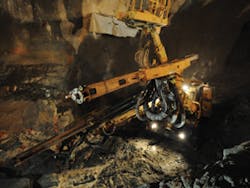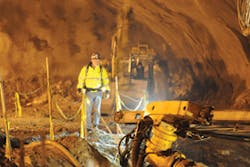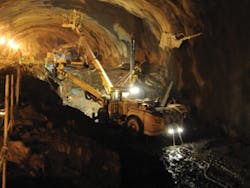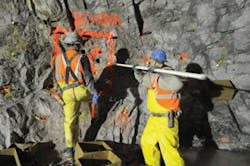A New York City tunnel project will extend a subway line to better connect the ends of the city. The Line 7 project is near the Jacob K. Javits Convention Center and is also part of the Hudson Yards redevelopment project.
The $1.2-billion tunneling job is a joint venture involving three construction giants: J.F. Shea Co. Inc., Skanska USA Civil, and Schiavone Construction. Together they make up the general contracting entity called S3-II Tunnel Constructors, J.V. An Atlas Copco Boomer and ROC D3 make up part of the equipment for the project, which consists of 6,000 feet of double-tube tunneling and 1,200 feet of cavern. Work under way is expected to be completed late in 2010. When complete, the cavern will be 55 feet high by 65 feet wide.
The project’s equipment superintendent, Kelvin Sampson, says, “The Boomer spent as much time in the air as it did drilling when the project began.” The shaft was drilled and blasted vertically using
ROC D3 crawler drills. Once a 100-foot depth was reached-30 feet of overburden and 70 feet of rock-the cavern excavation began.
Face drilling on the project is done during two shifts with two drillers on each drill. The Atlas Copco Boomer E2C 18 was modified for speed with two control panels. The drill is also performing a dual function of drilling for blasting and bolting. It’s also outfitted with a man-basket for the overhead bolting work.
The Atlas Copco Boomer E2C 18, with its computerized drilling function from the Rig Control System, was modified for speed with two control panels. The drill is also performing a dual function of drilling for blasting and bolting. It’s outfitted with a man basket for overhead bolting work.
The project called for a total of 150,000 cubic yards of excavated rock. The horizontal drilling work was performed by the Boomer E2C, but the ROC D3 was critical for the vertical work and sinking shafts. The use of the ROC drills allowed for floor, ramp and shaft work to be performed while the Boomer worked in other areas.
“Those [ROC] D3’s can go anywhere and climb any incline [we have encountered],” says driller Jim Lawson.
The Atlas Copco store in Clark Summit, PA, also supplied a service technician for each shift. “We work with the contractor’s service and maintenance crews, making sure all maintenance work is done right and on schedule,” said Jim Mattila, one of Atlas Copco’s service techs on site.
“The working head of the cavern is being drilled in three facings,” said Lawson. The center section works 30 feet ahead of the two sides. All hole patterns
and depths are preplanned and displayed on the screen. Once the driller moves his boom into place, an “X” on the screen shows the driller where to place the 1-and-seventh-eighths-inch bit. There is also a leveling function to let him know he is drilling a perfectly straight hole.
Lawson commented that the drilling is efficient. “The drill automatically drills the hole once I set it up on the hole-slower at first to collar the hole then speeding up as it goes. Each hole takes less than two minutes,” said Lawson. “This drill is all about working smarter, not harder-it does it all.”
Lawson also said the rig’s automated drilling function keeps him from getting stuck. “It was tough trusting the drill to do the work, but after a few weeks, I was comfortable with it. It’s really nice if you run into a void or shale. With the rig’s anti-jamming feature, this drill doesn’t get stuck,” said Lawson.
Overall the drillers and management have been happy with the success of Atlas Copco’s equipment. The round-the-clock service from Clark Summit and a 36-hour parts guarantee also lets the crew rest a bit easier.







